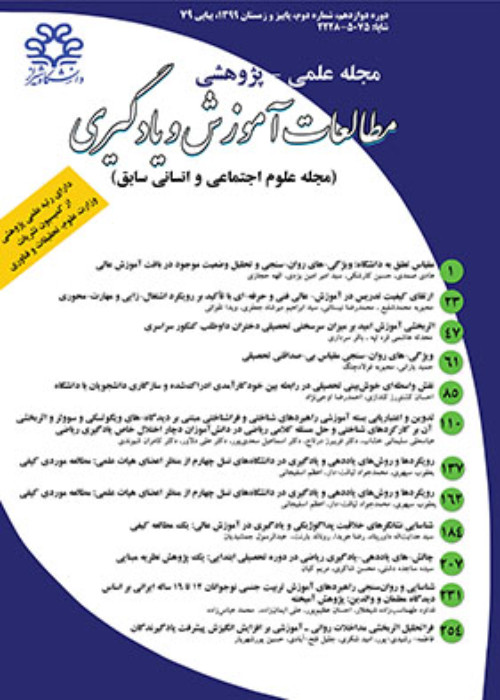Identifying the Effective Architectural Components for Promoting Students’ Learning by emphasizing the open spaces of schools on the basis of the document of the fundamental transformation of education
Author(s):
Article Type:
Research/Original Article (دارای رتبه معتبر)
Abstract:
Introduction
Education and training are fundamental for building a healthy society in the future. The adaptation of the learning context to the learner’s needs has been an important focus in recent years due to the growth and wide-spread changes in educational practices. It is believed that these values function as the principles that help define the professional practices taking place in schools. Paying attention to the buildings and closed spaces of schools and lack of attention to open spaces have been the main weaknesses of schools in Iran and the existing open spaces do not fully address the educational needs of students. The open spaces allow the students to utilize an environment for more informal educational means. Accessibility of open and green space within the schools is important for certain groups of users. This research seeks to find practical ways to design educational spaces that enhance students’ enthusiasm for learning. In contrast to most previous studies that considered one or a few variables to address the problem, the present study tried to take into account some of the most important components for designers.
Research Questions
Based on the objectives, the current research attempted to answer the following main questions: 1. What elements of architectural design of educational spaces are used in order to increase student’s learning efficiency? 2. Which design guidelines are considered important by experts in spatial organization of schools to improve students’ learning and creativity?
Methods
The research method used in this qualitative study was the Delphi technique. The Delphi method is a structured communication technique or method, originally developed as a systematic, interactive forecasting method which relies on a panel of experts. The experts answer questionnaires in two or more rounds. After each round, a facilitator or change agent provides an anonymous summary of the experts’ forecasts from the previous round as well as the reasons they provided for their judgments. Thus, experts are encouraged to revise their earlier answers in light of the replies of other members of their panel. Based on the nature of the study, a questionnaire was used as the main method of data collection. The structure of the questionnaire was based on closed questions, in order to standardize the responses and allow for easier categorization. The questions were taken from the subject literature and each item consisted of a 5-point Likert scale that ranged from “completely disagree” to “completely agree.” The study demonstrated the extent of influence of factors on increasing the students’ learning and creativity by utilizing the views of designers and architects, environmental psychologists, experts in educational spaces working in the Organization for Development, Renovation and Equipping Schools and senior officials of General Directorate of Education. A total of 95 invitations were sent out to the experts and 60 experts agreed to participate and completed the first and second rounds.
Results
Main domains were extracted from different literature, then they were classified into four groups, namely, physical, environmental, social relation, and furniture and equipment. Each of these groups contained some elements and there were 27 elements entirely. A t-test was used to determine whether or not the experts’ opinions on the first and second round were similar. The results demonstrated that a significance level of α=0.05 was reached, and the p-value of all criteria exceeded 0.05. The results showed a very slight increase in the convergence in round two from round one although no significant movement in the mean scores was found. Thus, it was felt that continuing the research for further rounds would not produce any extra convergence of opinions. The next step was to calculate ranks based on the importance of each factor. The research presents the results of the ranking and weighting of the factors by the experts according to the groups of factors. What immediately emerges in each case is the difference in importance ranking given by each group of participants. The results of ANOVA showed statistically significant differences between the designers, architects and environmental psychologists and experts in educational spaces working in the Organization for Development, Renovation and Equipping Schools and senior officials of General Directorate of Education and their opinions to several factors.
Discussion and Conclusion
Given the different needs of students, a framework for school design is presented to provide design guidelines for architects and professionals. There are some principles that can be used to promote student learning and to provide an environment favorable to education and creativity. It is clear that the designers and architects should consider stated factors and should adhere to the proposed principles and regulations to solve the present difficulties of educational spaces.Keywords:
Language:
Persian
Published:
Studies in Learning & Instruction, Volume:10 Issue: 2, 2019
Pages:
165 to 193
magiran.com/p1951470
دانلود و مطالعه متن این مقاله با یکی از روشهای زیر امکان پذیر است:
اشتراک شخصی
با عضویت و پرداخت آنلاین حق اشتراک یکساله به مبلغ 1,390,000ريال میتوانید 70 عنوان مطلب دانلود کنید!
اشتراک سازمانی
به کتابخانه دانشگاه یا محل کار خود پیشنهاد کنید تا اشتراک سازمانی این پایگاه را برای دسترسی نامحدود همه کاربران به متن مطالب تهیه نمایند!
توجه!
- حق عضویت دریافتی صرف حمایت از نشریات عضو و نگهداری، تکمیل و توسعه مگیران میشود.
- پرداخت حق اشتراک و دانلود مقالات اجازه بازنشر آن در سایر رسانههای چاپی و دیجیتال را به کاربر نمیدهد.
In order to view content subscription is required
Personal subscription
Subscribe magiran.com for 70 € euros via PayPal and download 70 articles during a year.
Organization subscription
Please contact us to subscribe your university or library for unlimited access!


